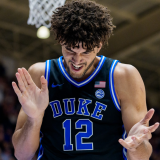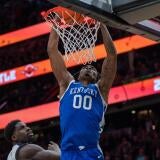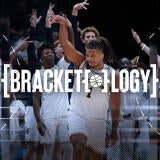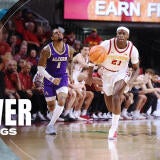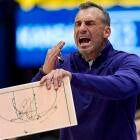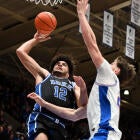NBA Draft prospect comparisons: Markelle Fultz has a lot of Bradley Beal in him
We draw our comparisons for the top draft prospects and current NBA players

Those who ignore history are doomed to repeat it. This is the prevailing logic behind the study of comps, players who profile as similar to prospects, allowing a window into if not what will be, at least what could be. So while we recognize that young future stars are individual snowflakes who think and feel as individuals, here's who some of the best to come remind me of.
Markelle Fultz, Washington
- Compares to: Bradley Beal
In Fultz, Washington has a player capable of controlling the pace beyond his years along with his other skills. Beal, for Billy Donovan's 2011-12 Florida team, played the third guard position, essentially a wing, but this represents both the abundance of playmakers Donovan had on even his non-Final Four teams, as well as a reminder of just how advanced Fultz's other skills are at a young age.
In his freshman year, Beal shot 44.5 percent overall, 33.9 percent on 3-pointers. Fultz checks in at 48.2 percent overall, 40.6 percent from 3-point range. Both of them are springy guards who rebound far better than their size should allow--Fultz is 6-4, Beal is 6-3, but each averaged six rebounds per game.
Watch his body control in the lane here, sending a defender flying by.
That's pure Fultz.
Lonzo Ball, UCLA
- Compares to: Kyle Lowry/Goran Dragic
This combo comp reflects the fact that there isn't currently a player in the league who's really like Ball -- with a playmaking ability like Jason Kidd, along with the physicality and 3-point accuracy.
In Lowry, there's the combination of finding teammates (Ball's current assist percentage of 32 percent is a bit higher than Lowry's career 30.1 percent mark) and shooting 3-pointers (43.1 percent for Ball, 42.9 percent for Lowry this season). But Ball finishes at the rim much more like Dragic when he broke out for the Suns, as seen here.
Jonathan Isaac, Florida State
- Compares to: Myles Turner
Both Isaac and Turner are part of the four-to-five players changing the NBA paradigm, and it is to Isaac's credit that he is ahead of where Turner was during his season at Texas. Both are long and lean block machines, with Isaac's block percentage virtually identical to Turner's this season in Indiana.
And just as Turner's figured out how to incorporate passing into his game now, Isaac does it already at Florida State, part of what makes the Seminoles such a difficult team to plan for. The talk about Kevin Durant for Isaac is understandable, but Isaac is really going to fit in this league as a perfect center for the age we're entering, as Turner shows here against last year's Warriors.
Lauri Markkanen, Arizona
- Compares to: Kristaps Porzingis
So this isn't a perfect comp: Porzingis' athleticism outstrips Markkanen's at this point, though it is worth wondering how much of that comes from the extra two years Porzingis has on him, and all the work he's put in the weight room.
Still, while it looks like Markkanen's frame can add significant extra strength, that will allow him to improve his post game, an area where both players have natural touch. And what really stands out here for Markkanen, and is identical to Porzingis, is that the combination of shooting ability, quick release and size -- like Porzingis, Markkanen is a legit 7-footer -- means they both get their shot anywhere they want it on the court.
If Isaac is emblematic of the age, Markkanen, like Porzingis, represent the outliers of it.
Dennis Smith, N.C. State
- Compares to: John Wall
This is an easy one. The otherworldly athleticism, the impossible-to-stop sojourns to the hoop, the playmaking and shooting skills--it is so easy to project what Smith can be precisely because of the trail set by Wall.
Notice how similar their numbers in college are, too: 46.1 percent overall and 32.5 percent from 3-point range for Wall, 49 percent overall and 36.9 percent from 3-point range for Smith, with Wall's 34.8 assist percentage at Kentucky a stone's throw from Smith's 36.2. Here, look at this and tell me you don't see John Wall...
Malik Monk, Kentucky
- Compares to: Eric Gordon
Watching the way Eric Gordon fits seamlessly into the Houston renaissance provides a window into the way the NBA can properly utilize Malik Monk once he arrives. It's fascinating, in retrospect, to think about the concerns over Monk's shot, now that he's essentially a 50-40-80 player for the Wildcats.
Like Gordon, his accuracy improved to ultimately match his athleticism, which itself allows him to play larger than his 6-foot-3 height. Gordon, too, adds more than a dash of passing to his repertoire, and both are posting assist percentages in low double-digits. And neither one is shy about attacking or sinking the midrange. Here's how a Monk signature game might look next year.
Robert Williams, Texas A&M
- Compares to: Kyle O'Quinn/Bismack Biyombo
Understand this about Williams: he's got the potential defensive impact overall of a Bismack Biyombo. But his game has more to it than just the raw, awesome potential of his reach and timing to block shots (why his block percentage is an astounding 11.1 percent).
His ability to distribute recalls O'Quinn, who is riding his particular set of skills in New York to an under-the-radar season of excellence. He's a better rebounder than O'Quinn, but just as well-rounded, with an ability to disrupt passing lanes that will make him a two-way player immediately. And expect Williams to do things like this.
De'Aaron Fox, Kentucky
- Compares to: Mike Conley
Leave aside the 3-point jumper, which ultimately showed up for Conley in the pros, and may well for Fox as well.
What Conley brings to the table, and Fox does as well, is a combination of playmaking skills and defensive stops. The latter, in particular, cannot be overstated in importance, given all the point guards proliferating the league. So here, take a look at how important that's been for Conley, because Fox's defense is a carrying tool from Day One.
Frank Ntilikina, France
- Compares to: Malcolm Brogdon
This requires some imagination. The issue with Ntilikina is that with a 170-pound frame on the 6-5 body, he isn't getting to the hoop with regularity.
Brogdon has 45 pounds on him. But Brogdon also played four years in college, and there's every reason to think that Ntilikina can get significantly stronger. What the two do similarly is see the game extraordinarily well, and use their height to see over the top of opposing defenses. Here's some of what Brogdon has been doing to make himself the most productive pick out of the 2016 NBA Draft so far.
It's what teams eager to get their hands on Ntilikina think he can do right away as well, while the rest develops.
Justin Patton, Creighton
- Compares to: Lucas Nogueira
The two players use their eerily similar frames (Patton 6-11, 215 and Nogueira 7-0, 220) to affect the game in similar ways. Long arms allow them to block shots (7.5 block percentage for Nogueira, 6.2 for Patton), while both of them rank near the top of the NBA/NCAA in points per possession scoring in transition, per Synergy.
Patton's post game is more developed than Nogueira, but they both also rate well above average for their size in ability to generate steals, and both of them can take those turnovers the other way for easy buckets. Watch Nogueira do this here.


